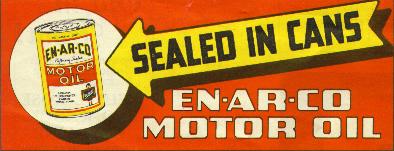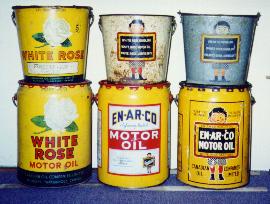
I will try and show a complete line of White Rose Quart Containers. I tried to photograph them in chronological order but there could be areas of new or discontinued product lines, and packaging that overlap, or change in mid generation.


"Sealed in Cans" appeared in a 1934 advertisment showing a Boy and Slate Quart. These were now the seamed cans most of us think of when someone mentions quart cans.Bulk sales with oil bottles continued for many years.I believe this generation all say "Toronto Canada." Buying Oil in sealed quarts increased the price by five cents/quart over bulk purchases.
 |
(L to R)
-En-Ar-Co Penn was a premium grade Pennsylvania Oil refined by National Refining and distributed by Canadian Oil Co's in Imperial Quarts (1936) -En-Ar-Co Motor Oil was Canadian Oil's premium oil. 'Refinery Sealed' was shown in script. -National Motor Oil in Black and Yellow cans (at varying prices) was the lower priced oil. - (not shown) En-Ar-Co Glycerol Antifreeze(Glycerine and Alcohol) ------I am not certain that this can exists as I have yet to see one. This product although available may have been dispensed from bulk containers-----. |
After becoming 'All Canadian' in 1938, the 'rose' appeared for the first time on cans. This generation had fantastic colours and graphics. A slogan --"Branchs throughout Canada" --is added at the bottom front of cans.
|
|
(L to R)
-Enarco Penn(see description in previous photo) -Enarco Motor Oil becomes a medium priced oil -National Motor Oil continued in the black and yellow can but changed mid-generation to the pale green with red script and remained the lowest priced oil. -White Rose Dursol Heavy Duty (Gas & Diesel) -White Rose Motor Oil (yellow) is the premium grade Later Heavy Duty script was added in red, then green in block letters under the words motor oil -Slovap, which stood for "Slow Evaporation" was the cheaper alcohol antifreeze. -White Rose Antifreeze - The blue can 2nd from last is early Ethylene Glycol. The wording on the can says, neither "Toronto" or "Branches throughout Canada." This can was replaced by the blue can at the bottom right of the photo. Although this is a terrible picture, in 1946 Canadian
Oil Companies introduced Aviation Products consisting of
|
|
|
(L to R)
-EnArCo is now the lower priced oil -White Rose Ultra Heavy Duty is a premium grade -White Rose Motor Oil Heavy Duty is the base grade -White Rose Ultra Multigrade(Gold and White can) -NEW Automatic transmission fluid -(Not shown)White Rose Permanent Antifreeze in royal blue with a white band at the bottom and white speckles around the rose. -(Not shown) White Rose Dursol (red can) and National (pale green) in previous pictures were continued with their same containers. |
|
|
(L to R)
-Enarco Motor Oil -White Rose Heavy Duty -White Rose Ultra-Heavy Duty -White Rose Dursol Heavy Duty -White Rose Ultra Multigrade -White Rose Permanent type Antifreeze(Glycol) - (not shown) White Rose Antifreeze (Alcohol) -White Rose Automatic Transmission Fluid |
I call this the 'Small Wedge' series. These started out as metal cans, but switched to composite (cardboard). Canadian Oil was bought by Shell in late 1962, and all cans now say "Canadian Oil Company - A division of Shell Canada " vertically on the side panel . "HOMOGENIZED" is no longer on the lids,but questions are printed on some bottoms to be read as the oil is poured into the engine. ei. -"How are the spark plugs?"--or--"Engine tune-up needed?"
|
|
(L to R)
-White Rose Ultra Heavy Duty -White Rose Ultra Multigrade -White Rose Detergent -Enarco Non Detergent -NEW White Rose Ultra L-D -White Rose Dursol Heavy Duty -Automatic Transmission Fluid -(Not Shown) Antifreeze, White Can, Navy Band at bottom, Small wedge logo. |

|
|
The metal shortage during World War
2 brought the appearance of a short, squatty, heavy composite container.
I have the En-Ar-Co version and have seen a yellow "White Rose" also.
Another oddity is the 'No Label Tin' in the middle. White Rose and the weight is on the lid, and I presume these cans were not seen by the public, but were removed from the top of the case and emptied directly into the vehicle in the service bay.Because there are no A.P.I. classifications on this can I will date it between 1938 and 1952, possibly wartime to save lithographing supplies and costs. Although the next tin is not oil it is a Quart of the same style (1938-1952). White Rose Tune was a Gasoline Additive but was also recommended to add to the Crankcase Oil for breaking in new and reconditioned 'Spark Ignition Engines'. |

   |
En-Ar-Co Oil(in the Boy and Slate quart),Slovap and White Rose (in the yellow quart) were also available in sealed one gallon tins that looked like large scale quarts.Although En-Ar-Co Penn oil was sold like this in the U.S.,only imperial quarts of these were available in Canada.
5 Gallon Tins
Bottom Row
Canadian Oil Co's were so proud of their can graphics
|
In 1951 Canadian Oil claimed to be the only Canadian
manufacturer of 'homogenized' oil.This is how they described the
process.
"The Homogenization of lubricating oils is the latest advancement in processing techniques. Just as homogenized milk holds cream in even suspension throughout,so the homogenization of lubricating oils holds all the ingredients in uniform solution.This means they will not separate under any storage or operating conditions and thus will always perform their specific functions with the utmost efficiency".
In July 1926 the Society Of Automotive Engineers
(S.A.E.) crankcase oil viscosity numbers were adopted. (ie. SAE 30)
By late 1933 Winter oils were classified
in accordance to their viscosities @ winter temperatures, these are marked
without the SAE but with a 'W' . (ei. 20-W ) Multi -Grades were available
by 1957 ( ei . SAE 10 W 30)
The second system of motor oil classifications was established for the petroleum industry by The American Petroleum Institute (API ).This system classifies oil by types according to the design and operating conditions of the engines in which the oil is to be used.The first types were REGULAR,PREMIUM and HEAVY DUTY.In 1952 API replaced these types with:
MM - medium duty
MS - severe duty
DG - severe (diesel)
DS - extremely severe (diesel)
DM - severe(diesel) was added by 1957 ( DG now becomes NOT severe)
This information, when compared to can markings, can be extremely helpful in dating oil cans etc. Other valuable resources are the physical characteristics, especially of the lids, stampings, script styles and slogans. If you find a 5 gallon pail similar to your quart, you are in luck. They have a date stamped on the bottom.